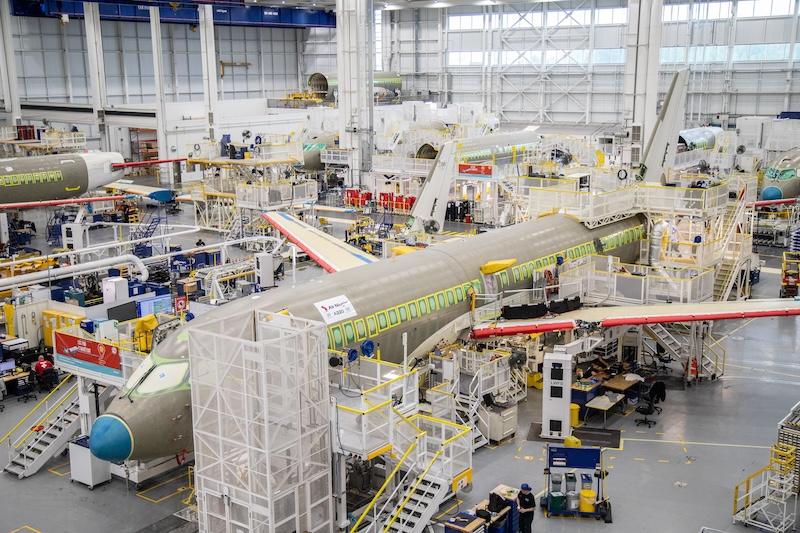
LE BOURGET—Airbus says it has seen a “real inflection point” since the beginning of the year when it comes to the overall performance of its supply chain, but engines and cabin parts continue to be a major challenge for the time being.
The number of missing parts came down by 40% by the beginning of the year, said Florent Massou dit Labaquère, Airbus’ commercial executive vice president of operations, during an update for investors on the sidelines of the Paris Air Show. “This is a big difference in our capability to stabilize the system,” he said. According to Massou, Airbus has not deviated from its production plans since the beginning of the year.
The level of missing parts in the overall production system is now at the same level as it was in 2018 or 2019, before the supply chain crisis unfolded. “But we should be different,” Massou said, as Airbus is targeting much higher rates. On the systems level, Airbus is already “much lower than in 2018-19.”
Having put out 766 commercial aircraft in 2024, the company is targeting around 820 in 2025, but still well below the 863 it reached in 2019. Airbus is also planning to ramp up A220 monthly rates to 14 by 2026, A320neo family to 75 by 2027 and the A350 to 12 by 2028. The A330neo is to remain at four. Airbus Commercial CEO Christian Scherer said he was “convinced that rate 14 is quite sustainable” and “before long, you will see it go higher,” although that has not been formally decided. The A330neo is also a candidate for higher rates, given recent sales success, but for now Airbus is prioritizing the ramp-up of the A350 and the A320neo.
Airbus claims to have fundamentally reset the relationship with its supply chain over the last year or so. “What we have changed is the understanding of what has prevented our suppliers to ramp,” Massou said. “We have been surgical on that.” Measures differ from supplier to supplier. Sometimes, Airbus has agreed to “re-pricing” (price increases), sometimes it has taken inventory, and sometimes it has advanced cash payments enabling its suppliers to buy materials.
And Airbus has also been willing to build its own inventory to ensure the production growth will continue, even with temporary shortages of some parts and components continuing. “Inventory is good cholesterol,” Scherer said. “It has taken us significantly more effort to convince the supply chain of [planned] rates,” he added. Therefore, he is hesitant for now to “move the goalpost again,” although it is “not impossible that we may move again in the future.”
On the other hand, the strong demand combined with constrained capacity allows Airbus to “consolidate pricing,” Scherer said. That is particularly important as the measures to strengthen the supply chain come at a significant cost, with more competitiveness and unit cost reduction to be regained as production increases are achieved in the coming years.
According to Massou, on the engine supply side, “the CFM side is the most critical, but different from last year.” In 2024, materials shortages impacted the number of Leap-1A engines that could be delivered, even though CFM International prioritized shipments to the final assembly lines over the in-service fleet for some time. That reversed at the beginning of this year. CFM also suffered from a six-week strike that brought engine production essentially to a halt. “CFM now needs to recover that quickly,” Massou said.
Airbus decided to continue to build A320neo-family aircraft at pace, resulting in “a few teens” of single-aisle aircraft being parked in Toulouse and Hamburg awaiting engines. Getting them delivered will be “the challenge of the year,” Massou said, although Scherer pointed out that Airbus’ guidance for output is not changing. “We have a recovery plan,” Scherer said.
By contrast to CFM, Airbus currently has “no issue” with deliveries of Pratt & Whitney PW1500G powerplants for the A220, and the situation on the A320neos/PW1100G has improved, too, Massou said. “We navigate with them the best trades.”
Massou also pointed out that while Airbus faced a lot of issues with Rolls-Royce three years ago, there is “no industrial problem” with its supplier of widebody engines today and there is “a good roadmap” in place for upgrades. “We invested a lot in our relationship with the engine suppliers in the last three years.”
However, Rolls-Royce’s price hikes for the Trent XWB-84 and -97 powering the A350-900 and -1000 implemented over the last two years continue to be a contentious issue, according to industry sources. In particular, Airbus lost out to Boeing on a large International Airlines Group (IAG) campaign for more widebodies to be placed into British Airways. IAG chose the Boeing 787 powered by GE Aerospace GEnx engines, with powerplant pricing a major factor in the decision, sources suggest.
A350 deliveries are being slowed down by shortages of cabin elements, including lavatories. However, Massou said that in May and June so far Airbus has received the number of lavatories—from Safran—that had been expected. But those delayed have yet to be recovered.
Taking over management control of Spirit AeroSystems’ Airbus production will play a key role in the group’s ability to grow A220 and A350 output, once the takeover closes in the coming weeks. Airbus has deployed teams of up to 20 people per site to each of the five Spirit production facilities that it will take over.
“We have a fairly good understanding of what needs to be done,” Massou said. Many of the shortfalls have to do with “issues of workmanship,” like the lack of good cleaning of molds in composite manufacturing that Airbus has identified in A350 fuselage section 15 production.





